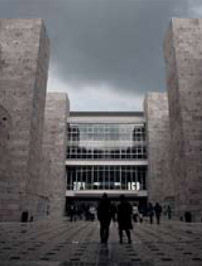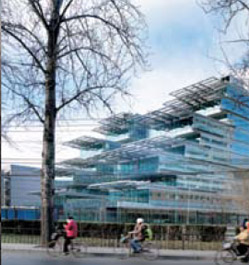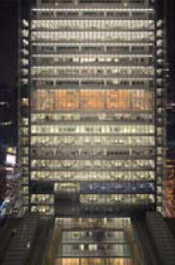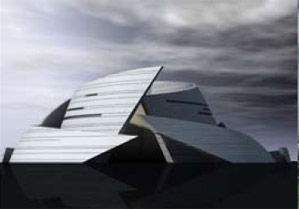
通过三届展会,中国国际建筑艺术双年展作为中国境内大型国际性建 筑文化艺术展示交流活动,正逐渐显示其中国特色:将以中国急需投入 的城市和建筑的具体建设项目为引擎,聚合国际优秀规划师、建筑设 计师、艺术家、人文学者,在诊断项目规划、开发、建设和管理途径的 同时,关注整体社会性思考和单体项目的实践运用,拉动宜居环境、社 会生态、人文科学等无数问题的多重交叉思考与对话,脱颖出科学的规 划设计解决方案,和开发、建设的多项资源汇合,研讨、实践节能、优 质、高效地空间创造,真实地累积人类建设文明。 今年3月28日被批准为北京市文化创意园区的D-park751,曾经是大型 动力工厂,在它占地22万平方米厂区内,2008第三届中国国际建筑艺 术双年展把以“城市/建筑:生态”为主题的五个展区,分布在2万余 平米的空间里。 河北唐山市曹妃甸国际生态城项目、山东滨州市的中欧航空科技城和黄 河岛文化艺术园区等项目展区突出,亮出各自愿景,必将成为不久的未 来国际合作的焦点项目。 建筑、社会、生命密不可分。由王明贤、朱青生等策划的“震后造家” 专题展,十几位业内知名的中青年建筑师自发地参与灾后重建而完成的 作品,体现中国建筑师责任。呼吁建筑师除了能够建造漂亮的房子,还 要关心这些建造的空间与社会的关系。 无论是规划设计方案还是装置艺术作品,都要在属于自己的独特空间里 展示生态、适宜环境。吴玮禾、白崇民策划、组织的40余名国际活跃 的装置、影象、行为艺术家参与了本次活动。利用厂区工业废旧材料的 装置艺术家,使厂区焕发出新的生机。 D-park751国际规划设计咨询展区,将举办“后工业时代城市文化遗产 的保护和发展”研讨会,由7位国际专家组成的评审委员会将与10组提 交方案的国际规划设计师共同探讨具有时代特征的中国老工业遗产如何 能尽快得到妥善保护和处理,尽快建立工业遗产保护制度。 10月25日至11月2日在5号展厅(751-E座)内8场国际论坛,将聚集城 市与建筑相关的若干可持续发展问题,各国建筑师代表将展示分享生态 城市与建筑的规划设计方面的成果与实践经验。 10月27日-30日,还将组织国际建筑师实地考察唐山曹妃甸国际生态城 (150平方公里)项目、滨州的中欧航空科技城项目(30平方公里)、 黄河岛文化艺术园区(24平方公里)、北京焦化厂(153万平米)和首 都钢铁厂(8平方公里)。 国际青年建筑师和学生建筑设计作品展吸引了58组活跃在世界建筑艺术 业的青年建筑事务所,以及美国、日本、西班牙、荷兰、瑞士、德国、 丹麦、英国、奥地利、澳大利亚、法国等11个国家的26所院校数十个 小组参加展览。由清华大学教授徐卫国和英国著名建筑批评家尼尔·林 奇共同策展的主题为“数字建构”,将国际最新的数字模拟、仿生建筑 赋予新奇的内涵和先锋实践的可操作性。展览同期,还将在清华大学建 筑学院举办相关论坛。 2008第三届中国国际建筑艺术双年展正以其丰富而务实的对话、交流和 行动,记录着中国与世界建筑师零距离合作,并共同撼动建设的真实。
罗丽博士
中国国际建筑艺术双年展总策划


After organizing the 3 biennials, the Architectural Biennial is getting its characteristic—to help the urgent construction projects in China and gather the international excellent urban planners, designers and humanists etc. for visiting and understanding deeply the projects in China, and finding the cooperation ways with the rich dialogues and effective practice, by gathering the social and creative resources. By the station of practice of the biennials, we should think over seriously and find responsibly the solutions for the complication construction, and build the human constructive civilization. March 28, D-park751, an original large power factory with 220,000m2 area, got the authorization with the cultural and design yard by the Beijing government welcomes the 3rd Architectural Biennial Beijing (ABB2008), covers about 20000m2 area, focusing on the main theme—Ecological City and Building with five exhibition hall and 8 forums.
The 3-day visits (Oct. 27-28) to the Caofeidian Eco-city Project (150km2) in Tangshan, Hebei province, the Sino-European Flight Industry Area (30km2) & Yellow River Island of the Culture and Arts (24km2) in Binzhou, Shandong province, Beijing Coking Plant (1530,000m2) & Capital Iron and Steel Plant (8km2) will lead the international architects to have a bridge for the future cooperation way smoothly.
Construction, society and life are intimate. Building homes after earthquake, the special exhibition area curated by Mr. Wang Mingxian, Mr. Zhu Qingsheng and the others, shows the responsibility of more than ten Chinese architects, who offered their works after earthquake with spontaneity for calling on the rebuilding of the homes, not only for the beautiful houses, but for the relationship between the spaces and the society.
No matter what the schemes of plan, design and the installation works are, all of them have their special exhibition spaces, to show their own ecological and fit environment. More than 40 active international installation, VD and action artists show the art works, organizing by Mrs. Wu Weihe and Mr. Bai Chongmin. Using the old and deposed materials of the factory to make the creative art works, they make the factory area vivid. The special exhibition of the International Consultant of Plan & Design of D-park751in Beijing, holding the forum “Protection and Development of the Old Factory in Central Town” on Oct. 26, combines the International Jury with the architects who offered the 10 plans for D-park751 for seeking the characters of the age for the heritage of old factories in China how to be protected excellently and found the system protecting the industrial heritage.
The 8 forums of ABB2008, held in No. 5 Exhibition Hall from Oct. 25- Nov. 2, will focus on the problems of the sustainable development of city and building with sharing the fruits of their practice in urban plan and design. (Im)material processes---New Digital Techniques for Architecture, the forum held in the Architecture College of Tsinghua University, takes the 58 groups of the international young architects studios and students from 26 architectural colleges in the 11 countries (USA, Japan, Spanish, Holland, Swiss, Germany, Denmark, England, Austria, Australia and France), curated by Mr. Neal Linch, the famous English architectural critic and Mr. Xu Weiguoo, the professor of the Architecture College of Tsinghua University, will show the international latest digital architecture simulation and its advanced maneuverability.
Recording the real cooperation between Chinese and international architects, ABB2008 is on the right way by its rich dialogues and vivid actions in the world wide.. DR. Luo Li Chief Curator of ABB2008








